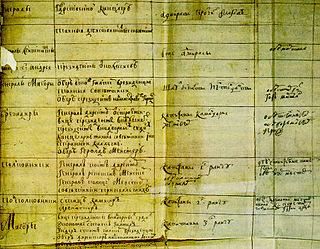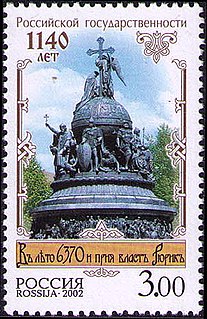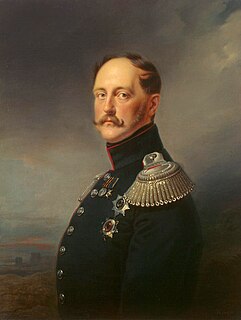The Tsarist bureaucracy, alongside the military, the judiciary and the Russian Orthodox Church, played a major role in solidifying and maintaining the rule of the Tsars in the Tsardom of Russia (1547–1721) and in the Russian Empire (1721–1917). In the 19th century, the forces of change brought on by the Industrial Revolution propelled many countries, especially in Europe, to significant social changes. However, due to the conservative nature of the Tsarist regime and its desire to maintain power and control, social change in Russia lagged behind that of Europe. [1]
The military history of the modern-day Russian Federation has antecedents involving the Rus', the Mongol invasion of the early 13th century, Russia's numerous wars against Turkey, against Poland, Lithuania and Sweden, the Seven Years' War, France, and the Crimean War of 1853–1856. The 20th century saw two World wars and the Cold War. The military history of the Russian Federation itself began in 1991.
The judicial system of the Russian Empire was established as part of the system of government reforms of Peter the Great.

The Russian Orthodox Church, alternatively legally known as the Moscow Patriarchate, is one of the autocephalous Eastern Orthodox Christian churches. The Primate of the ROC is the Patriarch of Moscow and all Rus'. The ROC, as well as the primate thereof, officially ranks fifth in the Orthodox order of precedence, immediately below the four ancient patriarchates of the Greek Orthodox Church, those of Constantinople, Alexandria, Antioch, and Jerusalem. Since 15 October 2018, the ROC is not in communion with the Ecumenical Patriarch of Constantinople, having unilaterally severed ties in reaction to the establishment of the Orthodox Church of Ukraine, which was finalised by the Ecumenical Patriarchate on 5 January 2019.
Russian-speakers referred to bureaucrats as chinovniki (Russian : чиновники) because of the rank or chin (Russian : чин) which they held. [2] Contrary to popular imagination, the Russian Empire was an under-governed country compared to the rest of Europe.

Russian is an East Slavic language, which is official in the Russian Federation, Belarus, Kazakhstan and Kyrgyzstan, as well as being widely used throughout Eastern Europe, the Baltic states, the Caucasus and Central Asia. It was the de facto language of the Soviet Union until its dissolution on 25 December 1991. Although, nowadays, nearly three decades after the breakup of the Soviet Union, Russian is used in official capacity or in public life in all the post-Soviet nation-states, as well as in Israel and Mongolia, the rise of state-specific varieties of this language tends to be strongly denied in Russia, in line with the Russian World ideology.

The Russian Empire, also known as Imperial Russia or simply Russia, was an empire that existed across Eurasia and North America from 1721, following the end of the Great Northern War, until the Republic was proclaimed by the Provisional Government that took power after the February Revolution of 1917.
| Country | Bureaucrats per 1,000 people in 1900 |
|---|---|
| Russia | 4 |
| Britain | 7.3 |
| Germany | 12.6 |
| France | 17.6 |
In 1718 Tsar Peter the Great investigated why the ex-Swedish province of Livonia was so orderly. [3] He discovered that the Swedes had spent as much on administering Livonia (300 times smaller than his own realm) as he spent on the entire Russian bureaucracy. He was forced to dismantle the province's government.

Peter the Great, Peter I or Peter Alexeyevich ruled the Tsardom of Russia and later the Russian Empire from 7 May [O.S. 27 April] 1682 until his death in 1725, jointly ruling before 1696 with his elder half-brother, Ivan V. Through a number of successful wars, he expanded the Tsardom into a much larger empire that became a major European power and also laid the groundwork for the Russian navy after capturing ports at Azov and the Baltic Sea. He led a cultural revolution that replaced some of the traditionalist and medieval social and political systems with ones that were modern, scientific, Westernised and based on the Enlightenment. Peter's reforms made a lasting impact on Russia, and many institutions of Russian government trace their origins to his reign. He is also known for founding and developing the city of Saint Petersburg, which remained the capital of Russia until 1917.

Livonia is a historical region on the eastern shores of the Baltic Sea. It is named after the Livonians, who lived on the shores of present-day Latvia.
Peter tried to pay his officials in money instead of letting them live off the land (a practice banned in 1714) and by bribery. In practice he only paid the Moscow and St Petersburg officials and in 1723 he used a quarter of the administration budget to pay off the deficit. Overall, Peter spent less than 4% of the Russian budget on administration. [4] :281–3
In 1722 Peter introduced the system of the Table of Ranks, a list of 14 ranks for the court, military and civil services. He intended to make the government meritocratic, but the system soon became corrupted.

The Table of Ranks was a formal list of positions and ranks in the military, government, and court of Imperial Russia. Peter the Great introduced the system in 1722 while engaged in a struggle with the existing hereditary nobility, or boyars. The Table of Ranks was formally abolished on 11 November 1917 by the newly established Bolshevik government.
Catherine II (later known as Catherine the Great) bought the support of the bureaucracy for her seizure of power (1762).[ citation needed ] From 19 April 1764, any bureaucrat who had held the same rank for seven years or more got instantly promoted. On 13 September 1767 Catherine decreed that after seven years in one rank, civil servants would automatically receive promotion—regardless of office or merit. [4] :135
Catherine changed the ecclesiastic provinces so they matched the administrative boundaries, thus increasing the bureaucracy's control over the church. [4] :243
Originally, achieving rank eight brought hereditary nobility. This was changed to rank five in 1845, and to rank four after 1856. The changes aimed to stop the dilution of the existing nobility with new careerists. [4] :125








